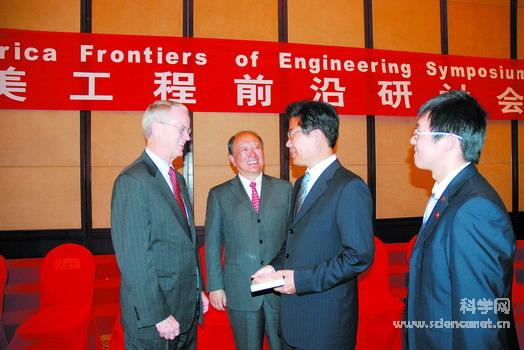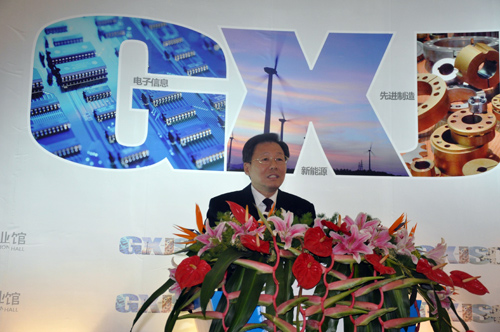|
CHINA SCIENCE AND TECHNOLOGY
NEWSLETTER
The Ministry of Science and Technology
People's Republic of China
|
|
|
N0.562 |
October 20, 2009 |
|
|
|
|
|
|
|
|
IN THIS ISSUE
|
|
*Three Vegetables Genomes Sequenced
*China-US Engineers Discuss Cutting-Edge Issues
*New Lupus Genes Found in Chinese Han
*Chinese Made New Chemotherapy Drug
*New Techniques for Treating Oil Contaminated Water
*China West Opens More to the World
|
|
INTERNATIONAL COOPERATION |
Three Vegetables Genomes Sequenced
Researchers at Institute of Vegetables and Flowers and Institute of Oil Crops, part of the Chinese Academy of Agricultural Sciences, have rolled out the full genome charts of Chinese cabbage, along with the framework genome charts for both broccoli and rape plants. The efforts have resulted in 500 million, 650 million, and 1.1 billion base pairs Studies for the three vegetables respectively. Chinese cabbage has 42,000 genes, and broccoli 45,000. Chinese scientists have completed the mapping of 85% of the genes possessed by the rape plant. Researchers told reporters that they have for the first time in the world sequenced the full genomes of Chinese cabbage, broccoli, and rape. Rape is the first heterogeneous tetraploid plant that has had a full sequenced genome in the world. The development marks an important progress made in understanding the evolution and genetic improvements of plants, and provides a valuable reference for sequencing other polyploid plants.
The sequence was kicked off in September 2008, with the participation of scientists from a number of countries, including China, the Republic of Korea, the UK, Canada, Australia, and the United States. All the member scientists involved in the project agreed to make the sequenced results and their own input data a standard sequence, at an international meeting on Chinese cabbage genome sequence held in August 2009 in Saskatoon, Canada. Researchers will soon start5 to refine the genome charts of both broccoli and rape plant.
China-US Engineers Discuss Cutting-Edge Issues

ZHANG Chunxian (right) chatting with XU Kuangdi (middle) and Charles M. Vest.
A symposium, co-sponsored by the Chinese Academy of Engineering and the US National Academy of Engineering, was held October 19-20, 2009 at Hunan University to discuss cutting-edge engineering issues. 34 American engineers and 40 Chinese engineers from different fields were present at the event. XU Kuangdi, President of the Chinese Academy of Engineering, ZHANG Chunxian, head of Hunan Province, Charles M. Vest, President of the National Academy of Engineering, ZHONG Zhihua, Chinese co-chair, CAE academician, and President of Hunan University, and Allen and Marilyn Puckett, American co-chair, and the National Academy of Engineering academician, attended the opening ceremony. Chinese and American engineers discussed a range of issues concerning engineering and public health, food safety, novel energy-saving technology, the sustainable development of infrastructures, disaster prevention and preparedness, and intelligent traffic system.
Home Made Test Kit for Heart Attack
Harbin First Bio-Engineering, in collaboration with University of Alberta, has successfully worked out a test kit able to detect the occurrence of heart attack in a fast manner. The test kit works on the fatty acids and proteins to tell the possible occurrence of heart attack. The highly specific monoclonal antibodies, developed by Chinese researchers as a raw material, makes the test kit enjoy an enhanced sensitivity approaching 89.6% , and a specificity as high as 96.2%. Able to tell if a heart attack is going on two hours after the occurrence, the test kit is easy for operation with a reduced cost.
New Lupus Genes Found in Chinese Han
A research team, led by Prof. ZHANG Xuejun of Anhui Medical University No. Hospital, has sorted out five susceptible genes (ETS1, IKZF1, RASGRP3, SLC15A4, and TNIP1) that may trigger up the occurrence of lupus erythematosus in Chinese Han people, and associated 4 vulnerable spots, in a controlled study of more than 12,000 lupus erythematosus patients and health people. The study also shows that seven susceptible genes found in Europeans are also seen in Chinese Hans. As an investigation covering so far the largest population in the area, the study has for the first time proved that different races have different susceptible genes for lupus erythematosus. The finding was reported in the October 18 online issue of Nature Genetics.
The study, funded by the National Natural Science Foundation and Anhui Dept. of Science and Technology and Dept. of Finance, was a collaborative project initiated by 17 Chinese research institutes, including Chinese National Genome Center at Shanghai and Fudan University Huashan Hospital, working on the samples collected from more than 40 domestic hospitals.
Chinese Made New Chemotherapy Drug
Shanghai based Fudan-Zhangjiang Bio-Pharmaceuticals announced recently that it has rolled out a proprietary Doxorubicin Hydrochloride Liposome, based on 6-year efforts. The new chemotherapy drug, designed to fight cancers using the state-of-the-art implicit liposome technology, can be clinically applied to treating a wide range of cancers, including breast/ovarian cancers, lymphoma, multiple myeloma, leukemia, stomach cancer, liver cancer, soft tissue sarcoma, and brain/neck tumors.
Doxorubicin Hydrochloride Liposome is a chemotherapy drug able to hit specific tumor tissues in a precise manner. Thanks to greatly reduced side effects, including damage to both heart and nervous systems and hair loss, the new drug raises the therapeutic effects of chemotherapy, without hampering the functions of normal tissues. Comparing with traditional chemotherapy drugs, it is wrapped up in liposome to reduce the toxicity, while enhancing the therapeutic effects. It changes the distribution of drug in human body, allowing more drug presence in tumor tissues, and less in normal tissues.
New Techniques for Treating Oil Contaminated Water
Based on 3-year tireless efforts, the Institute of Applied Chemistry, part of the Chinese Academy of Sciences, and Jilin Shenda have developed new techniques able to treat the waste water discharged from oil fields in a more efficient manner. Researchers rolled out highly effective waste water treatment and water plugging agents using oil field waste slurry as a raw material, allowing the solid wastes being turned into a useful material. Researchers also designed the techniques and facilities able to treat 300 tons of oil field waste water annually, desirable for the industrialized treatment of oil contaminated water from the oil fields and water returned from drilling. Test run at the Daqing Oilfield shows that the new techniques and equipment have worked smoothly to meet the waste water disposal needs of oil fields. The waste water disposal agent enjoys numerous merits, including fast dissolution, reduced dosage, demulsification, and fast fioculation. It is also of an enhanced salinity resistance, compared with the waste water disposal agents currently applied in the country.
China West Opens More to the World

The 10th China West International Fair opened on October 16, 2009 in Chengdu. LI Xueyong, Chinese Vice-Minister of Science and Technology visited the high technology part of the show before the opening ceremony. He thought highly of the initiatives to stage the show.
This is the first time for China West Fair to have a high tech section that covers an area of 11,500m2. The section is teemed with high tech products, lit up by 3D digital audio-video technologies, including e-books and 3D movies. Standing in the middle of the section is a large arc projection screen (35m, 120 degree, and 8 channels), the largest of its kind in the country. A group of robots, including face changing robots, robot band, and robot piano, have attracted visitors’ eyeballs.
An S&T project signing ceremony was jointly staged by the Ministry of Science and Technology and Sichuan Provincial Dept. of Science and Technology during the show. Shanghai municipal government sponsored a project talk aiming at expanding domestic needs for high tech products, with the Torch High Tech Center, part of the Ministry of Science and Technology, holding a China-EU talk on S&T incubators and international capital. 205 projects involving S&T findings spin-off, supporting the local development with science and technology, international S&T cooperation, and bank-industry cooperation, were signed up at the show, with a total amount of RMB 11.185 billion.
Large Volume Sodium Sulfur Cell
CAS Shanghai Institute of Ceramics and Shanghai Municipal Power Grid have worked together to achieve a major breakthrough in developing large volume sodium sulfur cell, through multi-year efforts. The proprietary 650Ah sodium sulfur cell they produced has made China the second country mastering the key technology of producing large volume sodium sulfur cell, in addition to Japan in the world. Chinese researchers developed some 170 sets of equipment able to assess the productivity and performance of the cells. They were installed in a pilot assembly line able to produce 2MW sodium sulfur cells. A 10kw energy storage demonstration was also staged. In addition, researchers prepared the documents needed for quality control, and established a multi-level security system to detect the dangerous sources in the production process, along with preventative and control measures. The core technologies derived from the project have applied for patents.
Largest Home Made Transformer
The largest home made transformer made its debut on October 1st, 2009 at Tianwei Baobian Transformer, indicating a new breakthrough made in developing China’s own large volume transformer. Chinese researchers have found solutions to a range of technologies for shaping up the largest volume transformer in the country. The first trial operation has won experts’ nod. The 1.14 million KVA/500KV transformer is a AC transformer designed to work for a mega kilowatt power generator in the country.
Fully Automated Flexible Press Line
Fully automated fast and flexible press line, a key technology project assigned to Jinan No. 2 Machine Tool Group under the National S&T Support Program for the 11th Five-year period (2006-2010), was built by researchers, after finding the solutions to addressing a range of key technologies, including fast horizontal rod feeding, linkage transmission, and overload protection. The press line, made up of one 2250T and three 1000T four-point multi-linkage presses, upper and lower feeding mechanisms, and mechanical arms, can be used to process the external covers of mini cars in an automated and flexible manner. One-year test run to process external auto parts in 13 specifications at an auto maker’s press workshop in Qingdao show that the press line works smoothly and reliably, with a rhythm reaching 12-14 parts per minute, allowing moulds being changed in five minutes. The system can work continuously, with all the technical indicators up to the design targets.
Next Generation Internet Storage System
Next generation internet information storage architecture and associated core technologies, a major project jointly undertaken by Huazhong University of Science and Technology, Tsinghua University, Peking University, and Wuhan University under the National 973 Program, is created to develop a new storage mode for meeting the information storage needs of next generation internet. Researchers have so far achieved numerous laudable results through 4-year efforts for the scalable multi-level storage system, including elaborating the behavior of network data storage, establishing a theoretical framework for self-assembly object storage system, and developing a range of core technologies for super large scale online storage system metadata management, and for relevant document mining. Researchers have also built a 500TB experimental storage platform connected to CERNET2 for both theoretical and methodological studies.
Blade Server TC3600

Front view of Dawning TC3600.
A blade server named Dawning TC3600 designed in line with international SSI standards and domestic HPCSC standards recently made its debut. As the third generation blade server after TC2600, the new system is developed by DAWNING to be compatible with the blade systems designed under SSI and HPCSC standards, in an attempt to raise the compatibility and reduce the costs for future upgrading. Dawning TC3600 is equipped with two Intel Xeon processors, a 96GB internal memory, and an optional IB slave card, scalable to two SAS hard disks, and compatible with SSI high and low speed modules, IB slave card, and management module.
Comments or inquiries on editorial matters or Newsletter content should be directed to:
Department of International Cooperation, MOST 15B, Fuxing Road, Beijing 100862, PR China Tel: (8610)58881360 Fax: (8610) 58881364
http://www.most.gov.cn |

